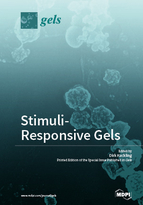Stimuli-Responsive Gels
A special issue of Gels (ISSN 2310-2861).
Deadline for manuscript submissions: closed (31 July 2017) | Viewed by 140869
Special Issue Editor
Interests: controlled polymer synthesis; polymer characterization; smart polymers; hydrolgels; actuators and sensors
Special Issues, Collections and Topics in MDPI journals
Special Issue Information
Dear Colleagues,
Although the technological and scientific importances of functional polymers have been well established over the last few decades, the most recent focus that has attracted much attention concerns stimuli-responsive polymer gels. These materials are of particular interest due to their abilities to respond to internal and/or external chemico-physical stimuli; such responses are often large and macroscopic. Aside from the scientific challenges of designing stimuli-responsive polymer gels, the main technological interests concern numerous applications, ranging from catalysis in microsystem technology and chemomechanical actuators to sensors. Since the phase transition phenomenon of hydrogels is theoretically well understood, advanced materials based on predictions can be prepared. Since the volume phase transition of hydrogels is a diffusion-limited process, the size of the synthesized hydrogels is an important factor. Consistent downscaling of the gel size will result in fast smart gels with sufficient response times. To apply smart gels in microsystems and sensors, new preparation techniques for hydrogels have to be developed. For upcoming nanotechnology, nano-sized gels as actuating materials would be of great interest. Finally, new design concepts for tough polymer gels are of interest for overcoming the mechanical shortcomings of conventional gels.
Prof. Dirk Kuckling
Guest Editor
Manuscript Submission Information
Manuscripts should be submitted online at www.mdpi.com by registering and logging in to this website. Once you are registered, click here to go to the submission form. Manuscripts can be submitted until the deadline. All submissions that pass pre-check are peer-reviewed. Accepted papers will be published continuously in the journal (as soon as accepted) and will be listed together on the special issue website. Research articles, review articles as well as short communications are invited. For planned papers, a title and short abstract (about 100 words) can be sent to the Editorial Office for announcement on this website.
Submitted manuscripts should not have been published previously, nor be under consideration for publication elsewhere (except conference proceedings papers). All manuscripts are thoroughly refereed through a single-blind peer-review process. A guide for authors and other relevant information for submission of manuscripts is available on the Instructions for Authors page. Gels is an international peer-reviewed open access monthly journal published by MDPI.
Please visit the Instructions for Authors page before submitting a manuscript. The Article Processing Charge (APC) for publication in this open access journal is 2600 CHF (Swiss Francs). Submitted papers should be well formatted and use good English. Authors may use MDPI's English editing service prior to publication or during author revisions.
Keywords
- stimuli-responsiveness
- cross-linking
- response time
- mechanical properties
- applications
- pH-sensitive
- temperature sensitive
- mechanical stress sensitive
- multi-stimuli responsiveness







